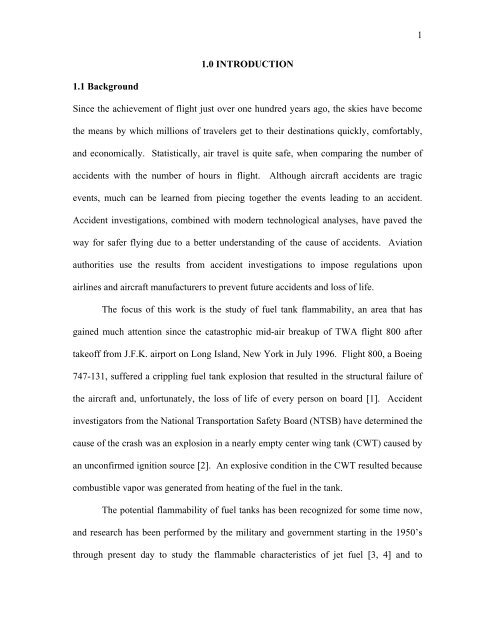Vaporization of JP-8 Jet Fuel in a Simulated Aircraft Fuel Tank ...
Vaporization of JP-8 Jet Fuel in a Simulated Aircraft Fuel Tank ...
Vaporization of JP-8 Jet Fuel in a Simulated Aircraft Fuel Tank ...
You also want an ePaper? Increase the reach of your titles
YUMPU automatically turns print PDFs into web optimized ePapers that Google loves.
1.1 Background<br />
1.0 INTRODUCTION<br />
S<strong>in</strong>ce the achievement <strong>of</strong> flight just over one hundred years ago, the skies have become<br />
the means by which millions <strong>of</strong> travelers get to their dest<strong>in</strong>ations quickly, comfortably,<br />
and economically. Statistically, air travel is quite safe, when compar<strong>in</strong>g the number <strong>of</strong><br />
accidents with the number <strong>of</strong> hours <strong>in</strong> flight. Although aircraft accidents are tragic<br />
events, much can be learned from piec<strong>in</strong>g together the events lead<strong>in</strong>g to an accident.<br />
Accident <strong>in</strong>vestigations, comb<strong>in</strong>ed with modern technological analyses, have paved the<br />
way for safer fly<strong>in</strong>g due to a better understand<strong>in</strong>g <strong>of</strong> the cause <strong>of</strong> accidents. Aviation<br />
authorities use the results from accident <strong>in</strong>vestigations to impose regulations upon<br />
airl<strong>in</strong>es and aircraft manufacturers to prevent future accidents and loss <strong>of</strong> life.<br />
The focus <strong>of</strong> this work is the study <strong>of</strong> fuel tank flammability, an area that has<br />
ga<strong>in</strong>ed much attention s<strong>in</strong>ce the catastrophic mid-air breakup <strong>of</strong> TWA flight 800 after<br />
take<strong>of</strong>f from J.F.K. airport on Long Island, New York <strong>in</strong> July 1996. Flight 800, a Boe<strong>in</strong>g<br />
747-131, suffered a crippl<strong>in</strong>g fuel tank explosion that resulted <strong>in</strong> the structural failure <strong>of</strong><br />
the aircraft and, unfortunately, the loss <strong>of</strong> life <strong>of</strong> every person on board [1]. Accident<br />
<strong>in</strong>vestigators from the National Transportation Safety Board (NTSB) have determ<strong>in</strong>ed the<br />
cause <strong>of</strong> the crash was an explosion <strong>in</strong> a nearly empty center w<strong>in</strong>g tank (CWT) caused by<br />
an unconfirmed ignition source [2]. An explosive condition <strong>in</strong> the CWT resulted because<br />
combustible vapor was generated from heat<strong>in</strong>g <strong>of</strong> the fuel <strong>in</strong> the tank.<br />
The potential flammability <strong>of</strong> fuel tanks has been recognized for some time now,<br />
and research has been performed by the military and government start<strong>in</strong>g <strong>in</strong> the 1950’s<br />
through present day to study the flammable characteristics <strong>of</strong> jet fuel [3, 4] and to<br />
1
















